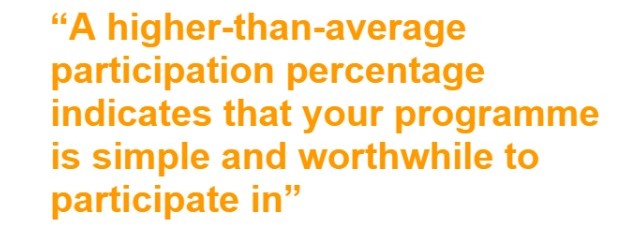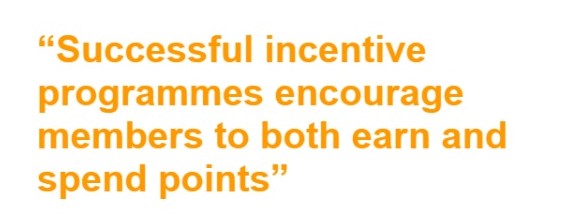How To Know Your Rewards Program Working? By far the best retention approach for growing your business and creating long-term client relationships is to develop a brand community with a rewards programme. Knowing whether your programme is achieving the desired results, on the other hand, is critical to maximising its performance and getting the most out of it. How To Know Your Rewards Program Working?
We’ve worked with tens of thousands of brands to create remarkable rewards programmes as the world’s leading rewards programme provider. This means we can analyse the statistics behind their accomplishment to assist you to improve the effectiveness of your own programme. How To Know Your Rewards Program Working?
Read these articles
Affordable New 30 Inexpensive Customer Appreciation Ideas
Is Customer Acquisition or Retention More Important?
Know more about Rewards Credit Card
How to make Loyalty Card Apps Making Loyal Customers?
Amazing Story of Hotel Rewards and Guest Loyalty
What are Loyalty Cards and how do they Work?
“You can’t manage what you don’t measure,” says one of my favourite quotes. You’ll be much more equipped to handle your rewards programme like a pro after you have two simple but enlightening rewards programme metric standards in your pocket.

The participation rate reveals how simple and appealing it is to join your programme.
Since repeat shoppers are your most valuable customers, knowing how effective your program is at capturing repeat buyers is critical since they are your most valuable clients. Converting a site visitor into a customer and that client into a repeat shopper are two of the most crucial conversions a brand can do. They’re also the two types of conversions that reward programmes excel at. A rewards programme, on the other hand, can’t do its job if customers aren’t participating.
This is why your involvement rate is so crucial. It’s one of the simplest metrics to compute, and it may give you significant insight into how simple your programme appears to your customers from the outside, in terms of how easy it is to join, how motivating it is to participate with, and how enjoyable it is to share.

Simply divide the total number of rewards programme members by the total number of consumers to get your participation rate. The calculated fraction indicates how many customers are actively participating in your rewards programme.

The typical rewards programme has a 23 per cent participation rate.
In our study of thousands of merchants who run reward programmes, we discovered that the average participation percentage is around 23%. That indicates that about a quarter of the customers of the typical brand we looked at participating in their rewards programmes. While this amount will vary depending on your objectives, it’s a good place to start when it comes to optimising and marketing your own rewards programme.
What you can learn from your participation rate
The fact that your rewards programme has a 23 per cent participation rate tells us a few things. For starters, it illustrates that your rewards programme is simple to identify and join, with a relatively painless adoption procedure.

Second, a high participation percentage indicates that your programme is actually beneficial to your clients. Customers would not join if they were not interested in the rewards you’re offering.
How to improve your participation rate
So, what should you do if you’re on the low end of the participation spectrum or simply wish to increase your overall involvement rate? You may convert more of your consumers into satisfied rewards programme members who return to your store by making a few simple changes:
- Check to see if you’re offering rewards that your customers want. The most successful incentive programmes understand what their customers value and then motivate them to achieve it.
- Promote your rewards programme on your website in a number of prominent locations. This could include a specialised programme page, a homepage, and a navigation bar. Customers will be hesitant to join a programme if they don’t understand how it works, so create a simple explainer website.
- Create an email campaign to offer your rewards programme to new and existing clients. These messages should explain the benefits of your programme, direct clients to further information on your store’s website, and make it easy for them to join!
The rate at which your programme is redeemed is a gauge of how engaging it is.
One of the most critical indicators you can use to gauge how well your rewards programme is doing is your redemption rate. Members will only be able to spend points if they interact with your programme, tying your redemption rate to customer engagement – which might be difficult to measure on its own.
While redemption rate may appear to be a difficult metric to calculate, it is actually quite simple. Simply divide the total number of points or rewards your customers have redeemed by the total number of points or rewards issued to determine your program’s redemption rate.

You can keep your finger on the pulse of how well your programme is doing by knowing its redemption rate. While having a consumer sign up for your rewards programme is a triumph in and of itself, it’s far from the end. Their actions within the programme will tell you a lot about how much value they’re getting from it and how likely they are to stay involved once they’ve joined. If consumers don’t perceive the benefit, you risk members abandoning your rewards programme and abandoning your brand community entirely.
As we previously stated, good customer involvement may account for up to two-thirds of a company’s earnings, therefore the redemption rate is a measure you shouldn’t overlook.
We divided our redemption rate analysis into two branches when doing our merchant research: points redemption and incentives redemption. Customers value points and actual prizes in very different ways, therefore we made this decision.
As a result, redemption rates for points are typically substantially lower than redemption rates for prizes. Because points simply indicate the possibility of a future reward, whereas a reward is a physical offer that is ready to be cashed, this is the case.

The average brand has a point redemption rate of over 13%. Customers who have redemption rates near to or over this number are clearly engaged with the rewards programme on a regular basis and are redeeming the points they earn for doing valuable actions. To put it another way, it verifies that the benefits you’re offering are worthwhile and that the activities required to obtain them are simple enough to be done on a frequent basis.
If your points redemption rate shows how eager consumers are to acquire points, your rewards redemption rate shows how enthusiastic they are to utilise them. When members see the value of your rewards and take advantage of them, your rewards have the potential to assist develop the emotional bonds that lead to long-term, real brand loyalty.

Approximately 66 per cent of brand awards were redeemed by customers, according to our research. To put it another way, barely a third of the prizes were not used! This demonstrates how effective incentive programmes encourage customers to acquire points and then spend those points on the desirable goods they’ve earned.
What you can learn from your redemption rates
The findings of our merchant achievements are a wonderful starting point for evaluating your own rewards programme.

If you have a points redemption rate of less than 13 per cent or a rewards redemption rate of less than 66 per cent, you should evaluate how appealing your rewards are and how motivating your earning behaviours are to get them. Low redemption rates are a sign that your customers are losing interest in your programme, and decreasing interest leads to fewer members, which means fewer sales.
How to improve your redemption rates

While low redemption rates are concerning, there are a lot of things you can do to improve the member experience and help them feel better:
- Engage consumers on their birthdays, on cart pages, and when rewards are most important to them in general to enhance your redemption rates. Re-engaging with your members at each of these points in the customer journey is logical.
- Make sure your rewards programme is appropriately using the power of motivation to attract members to join, connect with, and share your wonderful brand community by brushing up on Rewards Psychology 101.
- Take a look at our white paper on e-commerce reward redemption rates to see how providing more ways to earn and redeem points can increase redemption rates and how to prove it!
Get your rewards program working overtime
A rewards programme is an important component of a retention strategy that works around the clock to enhance your brand community and keep customers returning. You may evaluate your performance against successful rewards programmes and get your programme working overtime by paying attention to important indicators like participation and redemption rates.
You visit our website www.rewardcardsapp.com

